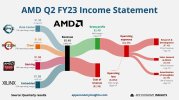true, but I was referring to message claiming that 2 GPU MI250 is useless.The comparison would be a bit more relevant if he used A100 since it has twice the memory bandwidth than the A6000 (~ 1500GB/s vs 800GB/s), then the comparison could be made using only 4 gpus for each vendor. He even states all that matters is memory bandwidth and capacity when examining individual gpu results using his fluid simulation app.
Some new results on kind of supernode:



